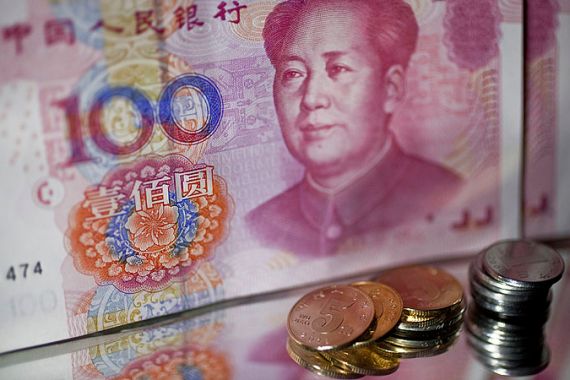Why a more flexible renminbi still matters
The case for China’s move to a more malleable exchange-rate regime remains strong.

Cambridge, MA – One of the most notable macroeconomic developments in recent years has been the sharp drop in China’s current-account surplus. The International Monetary Fund is now forecasting a 2012 surplus of just 2.3 per cent of GDP, down from a pre-crisis peak of 10.1 per cent of GDP in 2007, owing largely to a decline in China’s trade surplus – that is, the excess of the value of Chinese exports over that of its imports.
The drop has been a surprise to the many pundits and policy analysts who view China’s sustained massive trade surpluses as prima facie evidence that government intervention has been keeping the renminbi far below its unfettered “equilibrium” value. Does the dramatic fall in China’s surplus call that conventional wisdom into question? Should the United States, the IMF, and other players stop pressing China to move to a more flexible currency regime?
Keep reading
list of 4 itemsWhy are nations racing to buy weapons?
Parallel economy: How Russia is defying the West’s boycott
US House approves aid package worth billions for Ukraine, Israel
The short answer is “no”. China’s economy is still plagued by massive imbalances, and moving to a more flexible exchange-rate regime would serve as a safety valve and shock absorber.
That said, the exchange rate has received far too much focus as a lightning rod for concerns over China’s growing engagement in the global economy. The link between the exchange rate and China’s pricing advantages in world markets is wildly exaggerated. At the same time, the exchange rate is by no means the most pressing macroeconomic problem facing China today.
Over-reliance on investment
Rather, the biggest concern is China’s chronic over-reliance on investment as a driver of growth.
Investment constitutes almost half of GDP, more than twice the global average. At the same time, private consumption is under 40 per cent of GDP, with 60 per cent being a more normal figure for economies at similar levels of development. China’s investment appetite is unquestionably driven by huge intervention in the financial system: small savers receive only a paltry 1-2 per cent on their deposits in an economy that until recently has been registering 10 per cent annual growth.
The dramatic fall in China’s current-account surplus reflects four main factors. First, the cost of raw-material imports has risen sharply. At the same time, foreign demand for China’s exports is sufficiently sensitive that it cannot simply pass on the entire added cost.
A second important factor has been slow growth in the advanced economies, a by-product of the financial crisis that is likely to persist for some time to come.
Third, China’s trade-weighted real exchange rate (the exchange rate adjusted for inflation differentials) has actually appreciated quite a bit in the past few years – by 14 per cent since 2008, according to IMF estimates. China’s inflation has been higher than the average of its trading partners, and the renminbi has in fact strengthened gradually in nominal terms.
Finally, China engaged in massive investment stimulus as a response to the financial crisis. China’s investment is far more import-intensive than its consumption, which has continued to trend downwards. Countries like Germany and Switzerland have been huge beneficiaries of China’s seemingly insatiable appetite for high-tech capital equipment.
‘Nowhere to go but down’
Setting aside all of these specific drivers, we should hardly be surprised that China’s current-account surplus collapsed in the wake of the global financial crisis. With China continuing to record spectacular growth while the advanced economies were experiencing a deep slump, China’s exports, relative to imports, had nowhere to go but down. Indeed, in retrospect, what is surprising is that China’s trade surplus did not shrink even more.
The IMF reasonably predicts that, as the global economy normalises over the longer term, China’s current-account surplus will again occupy the same weight in global imbalances as it did a few years ago (about 0.5 per cent of global GDP).
All of this underscores the point that there is no monotonic relationship between the exchange rate and the current account. Capital-flow pressures, for example, can exert strong pressures of their own on exchange rates, independently of trade.
China has very strong capital controls, but they are far from impervious. With the prospect of modest rates of return in advanced economies, China has inevitably become a more attractive investment destination, despite a significant risk that China will someday experience its own sharp slowdown and financial crisis. (Those who think otherwise have succumbed to the “this time is different” mindset that Carmen Reinhart and I have emphasised in our research on financial crises through history.)
The real case for China moving to a more flexible exchange rate is that in any kind of crisis – economic, political, or otherwise – the exchange rate can provide an important stabiliser. Even if the renminbi appreciated in the near term, the effect on trade would probably be far less than American authorities wish and Chinese authorities fear. Studies on exchange rate pass-through suggest that US consumers would only see a small fraction of the cost change.
The simplistic logic often used to link the exchange rate and the current account is weak. But the case for China’s move to a more flexible exchange-rate regime, as part of broader financial-market liberalisation, remains strong.
Kenneth Rogoff is Professor of Economics and Public Policy at Harvard University, and was formerly chief economist at the IMF.
A version of this article first appeared on Project Syndicate.
